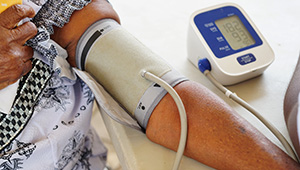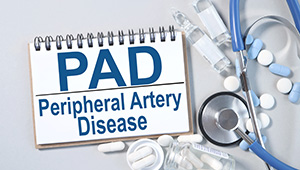September 2024 Dispatch for the CV Team
This month: BP cuffs don’t fit many Americans, a review for PAD awareness month, eating on anticoagulants, and more.

Every month, Section Editor L.A. McKeown curates a roundup of recent news tidbits from journals and medical meetings around the globe.
In patients with symptomatic obstructive hypertrophic cardiomyopathy (HCM), the cardiac myosin inhibitor aficamten (Cytokinetics), is associated with improvement in exercise performance measures, according to a prespecified analysis of the SEQUOIA-HCM trial. Published in JAMA Cardiology, the analysis shows that patients randomized to aficamten had better total workload, circulatory power, exercise duration, heart rate reserve, peak heart rate, ventilatory efficiency, ventilatory power, and anaerobic threshold compared with placebo.
 Approximately 40% of patients remain free from recurrence of arrhythmia at 3 years following a successful radiofrequency ablation or cryoablation procedure for atrial fibrillation (AF), a patient-level analysis suggests. Of the 15% of patients who had a very late recurrence, most episodes were fairly short and the overall AF burden was low, the investigators report in JACC: Clinical Electrophysiology.
Approximately 40% of patients remain free from recurrence of arrhythmia at 3 years following a successful radiofrequency ablation or cryoablation procedure for atrial fibrillation (AF), a patient-level analysis suggests. Of the 15% of patients who had a very late recurrence, most episodes were fairly short and the overall AF burden was low, the investigators report in JACC: Clinical Electrophysiology.
Nearly 20 million adults in the United States cannot use commercially available home BP monitoring devices because their arm circumference is either < 22 cm or > 42 cm, according to a research letter published in Hypertension by a high school student researcher. The limits on commercially available cuff sizes were found to affect 6.7% of all adult men and women in the US, including one in eight Black adults.
An analysis of over 8,500 cases from the British Cardiovascular Intervention Society database shows more in-hospital adverse outcomes—including death and major adverse cardiac or cerebrovascular events—with ad hoc unprotected left main PCI compared with planned/delayed procedures. In Catheterization & Cardiovascular Interventions, the researchers say these findings imply that outcomes may be tied to procedural planning and execution, specifically by ensuring “that sufficient time exists to complete all aspects of the procedure, ensuring that all interventional tools required (such as rotational atherectomy and imaging) are available, and perhaps most importantly, that the operator expertise to deal with procedural challenges . . . is available.”
Starting at age 40, a systolic BP of ≥ 140 mm Hg is associated with a threefold increase in risk of stroke for men and women, according to a longitudinal Norwegian study. Additionally, systolic BP ≥ 140 mm Hg at age 40 was a strong risk factor in women for incident cerebrovascular events, researchers conclude in Open Heart.
 September is peripheral artery disease awareness month and a comprehensive review article in JSCAI includes a broad overview of therapeutic strategies, including lifestyle modification and medical therapies, to consider. The authors urge clinicians to use multifaceted and personalized treatment strategies based on individualized risk profiles of PAD patients.
September is peripheral artery disease awareness month and a comprehensive review article in JSCAI includes a broad overview of therapeutic strategies, including lifestyle modification and medical therapies, to consider. The authors urge clinicians to use multifaceted and personalized treatment strategies based on individualized risk profiles of PAD patients.
A large registry study from China demonstrates ways in which clinical manifestations and in-hospital mortality rates differ between men and women with pulmonary embolism. While men had more chest pain, hemoptysis, and palpitations, the study published in Thrombosis Research found that women were more likely to have dyspnea, fever, and syncope. In-hospital mortality remained greater in men than in women even after propensity-score matching, suggesting the need for enhanced clinical awareness of symptoms that can drive mortality risk.
In light of recognized underuse of mineralocorticoid receptor antagonists (MRAs) in heart failure (HF) due to concerns about hyperkalemia and sexual side effects, a state-of-the-art review in JACC: Heart Failure delves into current evidence for the agents across the HF phenotype spectrum, and looks at future directions of nonsteroidal MRA research.
 Some interactions between food and anticoagulants are well known, while others are less so due to limited quality evidence in the literature. A systematic review of relevant articles published in Seminars in Thrombosis and Hemostasis sheds light on what is known about some of these interactions, including the impact of cranberry juice, green leafy vegetables, ginger, and mango on warfarin users.
Some interactions between food and anticoagulants are well known, while others are less so due to limited quality evidence in the literature. A systematic review of relevant articles published in Seminars in Thrombosis and Hemostasis sheds light on what is known about some of these interactions, including the impact of cranberry juice, green leafy vegetables, ginger, and mango on warfarin users.
Despite efforts to close the gender gap in participation in clinical trials, women remain significantly underrepresented in studies of novel diabetes drugs, specifically those where cardiac and renal events are the primary outcomes, a research letter in Diabetes, Obesity and Metabolism shows. The authors also found that in 20% of the studies they analyzed, the primary outcome was not reported by gender in the main study publication, frequently being relegated to the supplementary section of the article.
News Highlights From TCTMD:
Low Adherence to Secondary Prevention Recommendations Worldwide: INTERASPIRE
Yes, Clinical Inertia IS the Leading Cause of GDMT Underuse in HFrEF
Pandemic Burnout Survey Uncovers Work-Life Stressors Among Cardiology Staff
Little Pre- and Postmarket Testing for Most Recalled CV Devices
More Data Diminish Support for Cath Lab Fasting Rules: SCOFF
L.A. McKeown is a Senior Medical Journalist for TCTMD, the Section Editor of CV Team Forum, and Senior Medical…
Read Full Bio


Comments